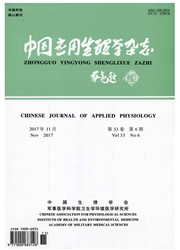

 中文摘要:
中文摘要:
Objective: To observe the ultrastructural change of the route of gut bacterial translocation in a rat with spinal cord injury(SCI).Methods: Forty Wistar rats were divided into the following groups: control group and 3 SCI groups(10 in each group). The rats in the SCI groups were established SCI model at 24 h, 48 h, and 72 h after SCI. Small intestine mucous membrane tissue was identified and assayed by transmission electron microscope, scanning electron microscope and immunofluorescence microscopy. Results: Small intestine mucous membrane tissue in control group was not damaged significantly, but those in SCI groups were damaged significantly. Proliferation bacteria in gut lumen attached on microvilli. The extracellular bacteria torn the intestinal barrier and perforated into the small intestinal mucosal epithelial cell. The bacteria and a lot of particles of the seriously damaged region penetrated into the lymphatic system and the blood system directly. Some bacteria were internalized into the goblet cell through the apical granule. Some bacteria and particles perforated into the submucosa of the M cell running the long axis of M cells through the tight junctions. In the microcirculation of mucosa, the bacteria that had already broken through the microvilli into blood circulation swim accompanying with erythrocytes. Conclusion: The routes of bacterial translocation interact and format a vicious circle. At early step, the transcellular pathway of bacterial translocation is major. Following with the destroyed small intestine mucous, the routes of bacterial translocation through the lymphatic system and the blood system become direct pathways. The goblet cell-dendritic cell and M cell pathway also play an important role in the bacterial translocation.
 英文摘要:
英文摘要:
Objective: To observe the ultrastructural change of the route of gut bacterial translocation in a rat with spinal cord injury(SCI).Methods: Forty Wistar rats were divided into the following groups: control group and 3 SCI groups(10 in each group). The rats in the SCI groups were established SCI model at 24 h, 48 h, and 72 h after SCI. Small intestine mucous membrane tissue was identified and assayed by transmission electron microscope, scanning electron microscope and immunofluorescence microscopy. Results: Small intestine mucous membrane tissue in control group was not damaged significantly, but those in SCI groups were damaged significantly. Proliferation bacteria in gut lumen attached on microvilli. The extracellular bacteria torn the intestinal barrier and perforated into the small intestinal mucosal epithelial cell. The bacteria and a lot of particles of the seriously damaged region penetrated into the lymphatic system and the blood system directly. Some bacteria were internalized into the goblet cell through the apical granule. Some bacteria and particles perforated into the submucosa of the M cell running the long axis of M cells through the tight junctions. In the microcirculation of mucosa, the bacteria that had already broken through the microvilli into blood circulation swim accompanying with erythrocytes. Conclusion: The routes of bacterial translocation interact and format a vicious circle. At early step, the transcellular pathway of bacterial translocation is major. Following with the destroyed small intestine mucous, the routes of bacterial translocation through the lymphatic system and the blood system become direct pathways. The goblet cell-dendritic cell and M cell pathway also play an important role in the bacterial translocation.
 同期刊论文项目
同期刊论文项目
 同项目期刊论文
同项目期刊论文
 期刊信息
期刊信息
